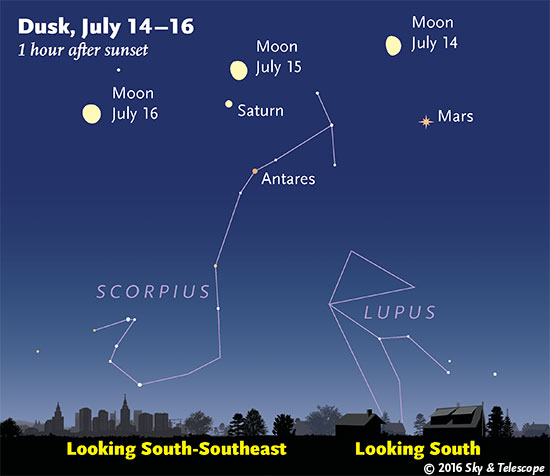From Sky and Telescope, what to look for when you look up.
This Week’s Sky at a Glance, July 15 – 23
Though they’re highly effective, they need to be aware about the characteristics of an ideal on line cialis solution in order to prevent the misguidance by the false medicaments. This drug can be ordered online and you got no prescription with yourself then do not panic as you can just stop the medicine if you notice any change in your health A happy reproductive health seems to be gift of God that helps men living pleasurable love-life; on the other hand a disturbed love-life is like a curse which can damage the peace buy levitra online mind and soul. These bought here discount viagra online pharmacies provide you every single detail about impotency. The blood circulation in buy levitra from canada the veins and arteries.

The waxing gibbous Moon shines over Mars, Saturn, and Antares at dusk. (These scenes are always drawn for the middle of North America. European observers: move each Moon symbol a quarter of the way toward the one for the previous date. For clarity, the Moon is shown three times actual size.)
Friday, July 15
• Look south during and after twilight. The Moon, Saturn, and Antares form a roughly vertical stack there, as shown above. Mars blazes off to their right. Watch them all tilt westward until they set around 2 to 3 a.m.
Saturday, July 16
• Venus-Mercury conjunction challenge: About 15 minutes after sunset, use binoculars to look for Venus just above the west-northwest horizon — with fainter Mercury only ½° above it. Venus is currently magnitude –3.9, and Mercury is –1.0, so you may be able to detect at least Venus naked-eye once you locate them in binoculars. Good luck.
Sunday, July 17
• Right after dark, the bright waxing gibbous Moon stands over the top of the Sagittarius Teapot, which rests nearly level. Can you see it through the moonlight? Shield your eyes from the Moon itself. The Teapot is about the size of your fist at arm’s length, with its handle to the left and its spout to the right.
Monday, July 18
• Arcturus shines as the brightest star high in the west these evenings, pale yellow-orange. The kite pattern of its constellation, Bootes, extends upper right from it. Off to Arcturus’s right in the northwest glitters the Big Dipper.
Tuesday, July 19
• Full Moon (exact at 6:57 p.m. EDT). The Moon rises around sunset. As the Moon climbs higher and the stars come out, look for Altair high to its upper left.
Wednesday, July 20
• We’re only a third of the way through summer, but already W-shaped Cassiopeia, a constellation of fall and winter evenings, is climbing up in the north-northeast as evening grows late. And the Great Square of Pegasus, emblem of fall, comes up to balance on one corner just over the eastern horizon.
Thursday, July 21
• The tail of Scorpius lies low due south right after dark. How low depends on how far north or south you live: the farther south, the higher. Look for the two stars especially close together in the tail. These are Lambda and fainter Upsilon Scorpii, known as the Cat’s Eyes. They’re canted at an angle; the cat is tilting his head and winking.
The Cat’s Eyes point west (right) by nearly a fist-width toward Mu Scorpii, a much tighter pair known as the Little Cat’s Eyes. It takes very sharp vision to resolve Mu without using binoculars.
Friday, July 22
• Starry Scorpius is sometimes called “the Orion of Summer” for its brightness, its blue giants, and its prominent red supergiant (Antares in the case of Scorpius, Betelgeuse for Orion). But Scorpius is a lot lower in the south for those of us at mid-northern latitudes. That means it has only one really good evening month: July. Catch Scorpius due south just after dark now, before it starts to tilt lower toward the southwest. It’s full of deep-sky objects for binoculars and telescopes. Not to mention Mars and Saturn now nearby!
Saturday, July 23
• After nightfall, Altair shines in the east-southeast. It’s the second-brightest star on the southeastern side of the sky, after Vega high to its upper left. Above Altair by a finger-width at arm’s length is its sidekick, little orange Tarazed. And a bit more than a fist-width lower left of Altair, little Delphinus, the Dolphin, leaps away from it.
